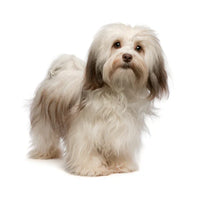Teacup Havanese
Happy. Devoted. Intelligent.
- Up And Away PupsHome
- Teacup Havanese
- Teacup Havanese

Teacup Havanese Puppies for Sale!
Indulge in pure cuteness with our Teacup Havanese puppies! Our adorable furballs are ready to bring boundless joy and companionship into your life. With their petite size and playful personalities, these pint-sized wonders make the perfect addition to any loving home.
Each Teacup Havanese puppy is bred with care, ensuring health, temperament, and breed standards are met. Known for their silky coats, expressive eyes, and gentle disposition, these puppies captivate hearts wherever they go. Don't miss out on the opportunity to welcome one of these enchanting creatures into your life.
Contact us today to reserve your Teacup Havanese puppy and experience the magic of unconditional love in miniature!
Breed Info
Temperament
Our Teacup Havanese puppy represents an adorable mix of devotion and affection towards their family. These small-sized companions would often infuse joy into every moment with their fun-loving and ever-happy disposition. Their playful nature has no bounds, and they are engaged in spirited antics that keep their families entertained.
However, they often display shyness, emphasizing the importance of early socialization that helps them blossom into confident adults. Their naughty side might come up as they are in search of ways to remove boredom whenever they are left alone for a longer time.
Therefore, it offers greater mental and physical stimulation that is important for their well-being. Our Teacup Havanese puppy enchants with their endearing traits, making it a cherished member across the household.
Appearance
Our Teacup Havanese puppy boasts a captivating appearance that is well-defined by their luxurious coat. It exudes charm and elegance with its long, silky, double-layered fur. The outer coat is light and airy, setting the stage for a shade of magical hayes. The Teacup Havanese comes in a spectrum of colors that will delight your eyes, from classic whites to rich browns, serene blues, shimmering golds, and striking silvers.
These pups come in different variations that include the warmth of fawn, the boldness of black, and playful combinations like brindle, tri-color, sable, part, Irish pied, black and white, and Belton. Each of these coat patterns narrates a unique story that enhances the pup's allure and individuality, making it a visual masterpiece and an adorable companion.
Exercise
The exercise routine for your Teacup Havanese puppy caters to their playful nature and indoor preferences. These pint-sized companions will thrive in warmer climates, making the indoor play sessions perfect for them. Engage in their playful instincts as the key to keeping them healthy and happy.
Although they might not need any extensive outdoor activities, they will still benefit from regular exercise. The suggested routine will include an hour of daily activity achieved through indoor fetch, interactive games, or short walks in pleasant weather. Aim for around 7 miles of walking each week to ensure they get adequate mental and physical stimulation.
Unique History of Teacup Havanese Puppy
The captivating Teacup Havanese puppy traces its origins to the Mediterranean region, where it began its journey centuries ago.
● Origins
These enchanting canines flourished in their new Caribbean home as they are believed to have been brought to Cuba in the 1700s. They were developed from two now-extinct breeds that contribute to their unique characteristics and charming personality. Teacup Havanese dogs have found their way into the United States, carried by families who fled from the political unrest. Despite the upheaval, these resilient pups brought joy and companionship to their new American homes.
● Popularity
In 1979, the Havanese Club of America was established, with a modest founding membership of just nine devoted enthusiasts. This marked the official recognition and promotion of the breed within the United States. Since then, the Teacup Havanese has captured the hearts of countless dog lovers worldwide, admired for its affectionate nature, elegant appearance, and playful demeanor.
Today, the Teacup Havanese continues to enchant families with its rich history and endearing qualities. It serves as a beloved companion and a reminder of the enduring bond between humans and dogs throughout the ages.
Maintenance of Teacup Havanese Puppy
Let us check out the maintenance and care routine for your Teacup Havanese pups.
● Grooming
The Teacup Havanese puppy's exquisite coat requires regular maintenance to keep it looking its best. If you plan to maintain a long coat, weekly brushing and bathing are essential to prevent mats and tangles. For short coats, trimming every six to eight weeks helps maintain a tidy appearance. The coat naturally cords and can be trained to do so for a distinctive look. Additionally, monthly nail trims and regular teeth brushing a couple of times per week promote overall health and hygiene.
● Training
Teacup Havanese puppies, known for their intelligence, are generally easy to train. However, they can be slow to housebreak, requiring patience and consistency. Positive reinforcement techniques work best, as these pups respond well to praise and rewards. With dedication and a gentle approach, you can effectively teach your Teacup Havanese puppy manners and obedience, fostering a strong bond built on trust and understanding.
FAQs About Teacup Havanese Puppies
Are Teacup Havanese Puppies Easy To Train?
Yes, they are generally easy to train due to their intelligence and eagerness to please. With consistent and positive reinforcement methods, they quickly learn commands and behaviors. However, they may be slow to housebreak, requiring patience and consistency from their owners to establish good bathroom habits.
What Is The Average Lifespan Of A Teacup Havanese Puppy?
Teacup Havanese puppies typically live between 12 to 16 years on average. With proper care, nutrition, and regular veterinary check-ups, they can enjoy a long and healthy life alongside their loving families.
Are Teacup Havanese Puppies Good With Family, Children, And Other Pets?
Yes, Teacup Havanese puppies are known for their affectionate and friendly nature, making them excellent companions for families, including children and other pets. They thrive on companionship and enjoy participating in the family's daily activities.
From Where Can I Get A Cute Teacup Havanese Puppy?
You can now locate your adorable Teacup Havanese puppies from our reputed platform, Up And Away Pups. Check us out to adopt your adorable companions. We are dedicated to our adoption, which features listings for the cutest Havanese pups.
Are Teacup Havanese Puppies Hypoallergenic?
While no dog breed is entirely hypoallergenic, Teacup Havanese puppies are considered to be low-shedding and produce less dander compared to other breeds. This characteristic may make them more suitable for individuals with allergies, but it's essential to spend time with the puppy beforehand to assess any allergic reactions.

























